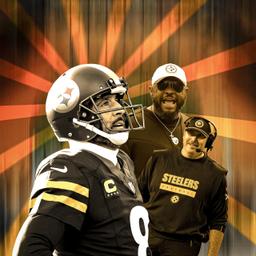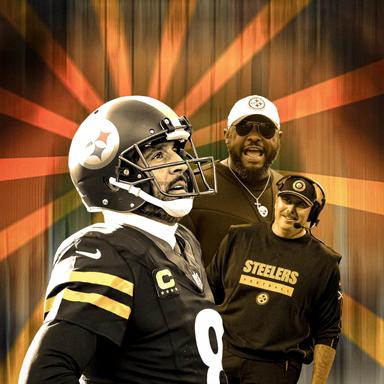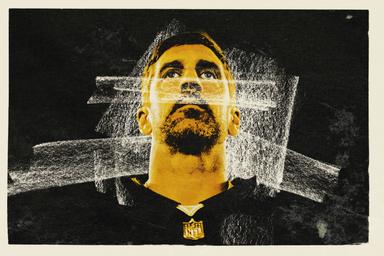
Pittsburgh Steelers head coach Mike Tomlin lived a charmed football life for the first 15 seasons of his head coaching career. He inherited an ascending franchise quarterback in Ben Roethlisberger. His first defenses were anchored by one of the three best safeties of all time in Troy Polamalu and one of the best pass rushers of his era in James Harrison. As those defensive leaders stepped away from the game, Tomlin filled those vacancies with All-Pro talents in T.J. Watt and Minkah Fitzpatrick—helping Tomlin sustain an 18-year streak of .500-or-better seasons.
Since Roethlisberger retired after the 2021 season, though, Tomlin’s franchise has been in the wilderness at quarterback—and Tomlin and his coaching staff have been wholly incapable of building a respectable offense. Taking Kenny Pickett with the 20th pick of the 2022 draft was a wreck, and Pickett was quickly jettisoned after two seasons to make way for the awkward Russell Wilson–Justin Fields experience we witnessed last season. After losing their final five games of last season by an average margin of 13.2 points, the Steelers let both of those quarterbacks walk in free agency (for starting jobs with the Giants and Jets, respectively), and now Pittsburgh welcomes 41-year-old Aaron Rodgers on a $13 million, one-year deal to hopefully accomplish what hasn’t happened since 2016 for the Steelers: a playoff win. The process of integrating Rodgers into the Tomlin way starts Tuesday, with Rodgers taking the field for the first time at the team’s mandatory minicamp.
Tomlin has tied his coaching legacy to an aging quarterback who hasn’t just lost a step but also pretty clearly has both feet pointed toward … whatever the hell he plans to do when he retires.
The reality is that on a snap-by-snap basis, Rodgers is now a mediocre passer with the occasional flash of high-end play—a profile more befitting of a rookie than someone who finished his college career in the same year that some of the NFL’s newest players were born. The only precedent we have for a quarterback turning a franchise into a contender after his age-40 season is Tom Brady, who may be the biggest age-defying outlier in sports besides LeBron James in the NBA and Jack Nicklaus in golf.
Aaron Rodgers’s Passing Production Since 2019
On the other hand, with the offseason winding down, what other choice did Tomlin have? Now that Rodgers is finally under contract and preparing to make his practice debut, we can evaluate the entire landscape to better understand how the Steelers landed here with Rodgers on a relatively cheap one-year deal.
ESPN’s Adam Schefter reported last week that Pittsburgh pursued a trade for Matthew Stafford before the quarterback ultimately re-signed in Los Angeles. Stafford was probably an unrealistic target, but it speaks loudly to the priority Tomlin places on veteran players over their younger counterparts—and hints at Pittsburgh’s reluctance to put up major draft capital or big money to compete at this position. When the pursuit of Stafford went nowhere, the organization turned its focus to re-signing Fields, but its unwillingness to match or exceed the Jets offer that included $30 million in guarantees signaled that it was never all in on bringing back Fields. The top free agent quarterback, Sam Darnold, wound up getting a hefty contract with the Seahawks that included $37 million guaranteed at signing. And instead of pursuing a trade for Geno Smith, the Steelers traded for one of Smith’s teammates, wide receiver DK Metcalf—a move I’m still trying to sort out because of what it cost to acquire and extend each player (three picks, including a second-rounder, and $60 million in guarantees for Metcalf, compared to just a third-round pick and $66.5 million in guarantees in the Raiders’ deal for Smith).
Two things never appeared to be a real option for Tomlin’s team: (1) drafting a quarterback in the first or second round and giving him a chance to prove he’s the long-term answer or (2) heading into training camp with Mason Rudolph as the presumed starter. Both of those alternatives probably would have meant accepting some pain in 2025 as part of an organizational reset, and Tomlin has made it clear that neither he nor the franchise as a whole is wired to operate that way. The Steelers have had a proud history of clawing for every win they can since Chuck Noll took over as head coach in 1969; the franchise has finished with a losing record just nine times since 1970 and only once since 2000. Pittsburgh is the NFL’s best proof that culture sustains winning much more than the inverse, and after fumbling through the past half decade, I understand why a veteran quarterback with Rodgers’s résumé is appealing to Tomlin.
He better be right about making things work with Rodgers, though, because the state of affairs with Pittsburgh’s passing attack has been about as bad as you’ll see in the league. Since 2022, the Steelers are 23rd in passing success rate, yards per attempt, and first downs gained on pass attempts, and they’re dead last in passing touchdowns, with just 46. The Steelers might’ve found ways to win ugly in the regular season, but the offense simply wasn’t capable of contending in the postseason against AFC teams featuring high-powered offenses led by true franchise quarterbacks. “Whatever way that [scoring more points] happens is whatever way that happens,” Tomlin said after the end of his 2024 season. “You’re not going to score 14 points a week in January and be successful.”
Tomlin’s statement was honest but not entirely indicative of a true openness to changing his approach to what makes for a good passing offense—that would require having a quarterback who can take chances and push the ball downfield. The Steelers have attempted just 304 passes of 15-plus air yards since 2022, ranking 27th in the league over that span. Part of that is a reflection of talent problems at quarterback, but it’s also informed by Tomlin’s rigid adherence to a risk-averse style of play. Bad things have happened to Steelers quarterbacks trying for chunk plays—Pittsburgh’s quarterbacks have tied for the fifth-highest interception rate (6.6 percent) on these passes over the past three seasons—but the expected points lost on those turnovers rank just 13th and suggest the danger is probably not as drastic as Tomlin believes it to be.
Tomlin has a long list of infamous metaphors and idioms—Tomlinisms—and his personal favorite seems to be that he’s in “the game of football and the business of winning.” But running a risk-averse offense has prevented the Steelers from keeping pace with the league’s real contenders. His conservative approach to quarterbacking oozes from nearly every remark he’s made about the position. When Rudolph lost the starting job in 2019, it was because he threw five interceptions in six quarters against the Bengals and Browns. When Tomlin spoke about Devlin “Duck” Hodges in Duck’s brief stint as the starter, he emphasized that taking care of the ball was the top priority. Pickett threw 13 picks and fumbled six times in his two seasons as Pittsburgh’s starter, and Tomlin was quickly ready to move on. Fields’s fumbles clearly irked Tomlin early last season—even though Fields lost only one of them—and seemed to lend credence to Tomlin’s steadfast belief that Wilson would be better for the offense.
And while no one would argue that any of those quarterbacks were on pace to save the franchise (lord knows that I wouldn’t), the Steelers do come across as one of the least quarterback-friendly environments leaguewide. Not only has Tomlin had little patience for mistakes, but he has also done a poor job of identifying offensive coordinators who can build a winning scheme since parting ways with Todd Haley after the 2017 season. The subsequent OC hires—Randy Fichtner, Matt Canada, and, most recently, Arthur Smith—have struggled to create efficient offense through the air or on the ground. (It’s notable that neither Fichtner nor Canada found work in the NFL after being fired by the Steelers.) This isn’t Cleveland-level quarterback purgatory, but despite the strong team culture and regular-season success in Tomlin’s tenure, Pittsburgh clearly has not been a place for quarterback development or offensive creativity to thrive.
Now, in a time when Tomlin needs his offense to undergo a philosophical facelift more than ever, he’ll turn to a quarterback most likely to play in exactly the way the coach has always preferred: safe. Rodgers has just 237 throws of 15-plus air yards in his last three seasons; this risk aversion keeps his interception numbers down, but he’s less effective because of it. As age and his Achilles tendon injury have slowed him down, my concern about how he handles pressure has risen. Rodgers’s sack rate when he’s pressured has been over 20 percent in each season since 2021, a big spike from his own 15.9 percent mark in 2020. Rodgers’s ceiling may still be decently high—he is still extremely accurate on those short throws and typically knows where to go with the ball—but it’s reasonable to expect that his overall play will continue to decline, especially coming off a season in which he was sacked 40 times. To try to get the most out of Rodgers, Tomlin may have to ask him to do less away from the football field while being more aggressive on it, an unenviable task for a head coach working with a player who is used to having an open mic on The Pat McAfee Show (among others) whenever he wants it.
As Pittsburgh’s mandatory minicamp begins, it’s hard not to look at Tomlin’s recent tenure through an Ozymandian lens. Every decision to squeeze blood from stone with an aging and flawed roster, the trade (and subsequent payday) for Metcalf, the assembly line of milquetoast offensive coordinators, and the endless carousel of middling quarterbacks have led the Steelers here: adrift in a sea of mediocrity, with new faces in old roles, slowly trudging toward an uninspired nine-win campaign before this franchise hits the reset button at the position again in the spring of 2026.
Since Tomlin stepped into the job in 2007, only New England and Green Bay have won more games than his Steelers—and only Baltimore, Kansas City, and New England have played in more playoff games in the AFC. He’s the most successful coach hired to his first head gig in this century, and his Super Bowl win and streak of winning seasons will land him in the Pro Football Hall of Fame whenever his career ends. There are some Steelers fans who are tired of hearing the same bullet points in his résumé, though, and I can’t blame them. And if this stint with Rodgers goes poorly, the critics will get even louder.
“There is football justice,” Tomlin said after his offense failed to rise to the occasion in last season’s wild-card loss to the Ravens. “You get what you deserve.”
In that light, if Tomlin believes he deserves the playoff wins that have eluded him for nearly a decade now, he needs to be willing to make an exchange: give up the conservative approach to the passing game for something more ambitious. Tomlin has never been the type to make excuses, and there are none to be found here, regardless. Pittsburgh has built one of the best young offensive lines in the league, nabbed a new top receiver, built up a defense with enough talent and depth to compete against any offense, and now dropped one of the most accomplished quarterbacks of a generation into the mix for his last ride. Tomlin has an opportunity to evolve right under his nose, but his philosophies and quarterback choices are standing in the way. Pittsburgh has been left behind by modern offenses, and there’s a difference between ugly wins (like we saw from Philadelphia and Kansas City last year) and winning in spite of barely viable offensive play (like we’ve seen from the Steelers over the past few seasons).
This is also a chance for Rodgers to shape the final chapter of his NFL legacy after things went awry with the Jets two years after a messy end to his time in Green Bay. He arrives in Pittsburgh with a reputation of being a malcontent, with several damning bullet points on his ledger. He isn’t shy about airing his grievances, football and otherwise, and nearly everyone from the Jets regime that brought him in and handed him an unusual amount of power was fired. His first coach in Green Bay, Mike McCarthy, got fired too. Matt LaFleur survived his time with Rodgers, though the two did have their issues.
It’s hard to imagine any one player being the reason Tomlin could lose his job, but turning Pittsburgh’s facility into the latest nuclear waste zone might be Rodgers’s pièce de résistance. Frankly, he’s already offended the proverbial football gods at several turns, but if Rodgers is seeking a glorious ending to his Hall of Fame career, one he didn’t get in New York, it will mean assimilating to a culture whose success predates him and will likely push on long after he’s hung up his cleats. He’ll also need to relinquish his need to influence every bit of the offense and seek out opportunities to take some chances when his body allows for it.
Now the stage is set for an aging star and a franchise in no-man’s-land to unmoor each other from a stretch of mediocrity. With the right adjustments in the offensive scheme from Tomlin and his staff and some willingness to adapt from Rodgers, this could be the NFL’s best redemption story. But if these two can’t muster the necessary courage to take a swing at building an aggressive passing offense to compete with the upper crust of the AFC, then an unceremonious send-off may be exactly the football justice this duo deserves.







